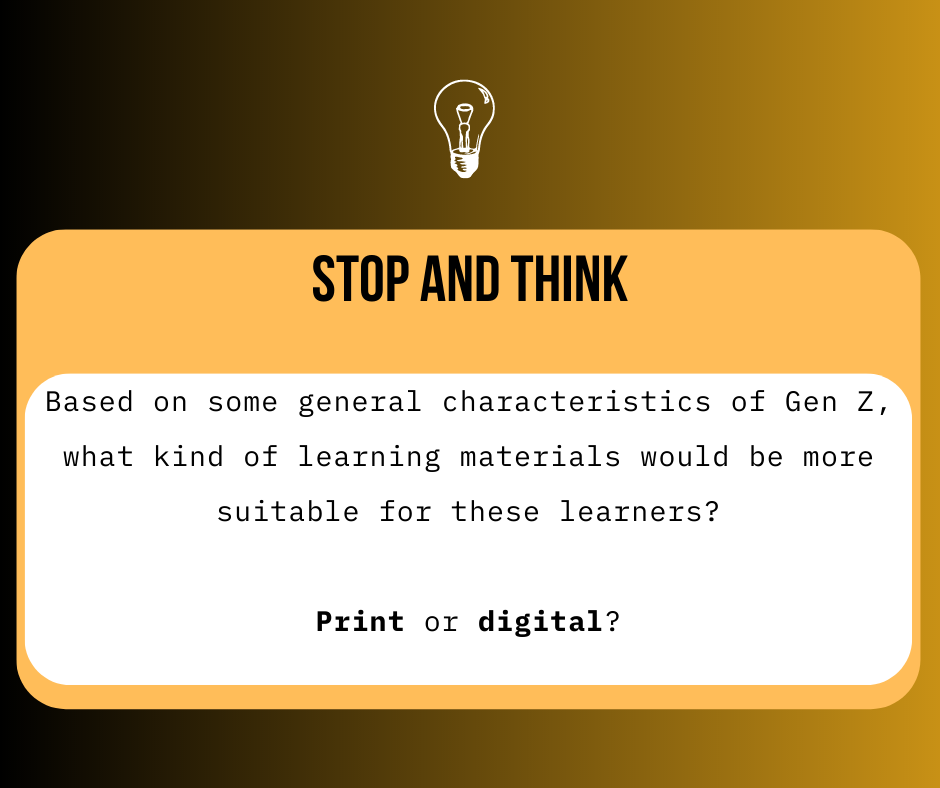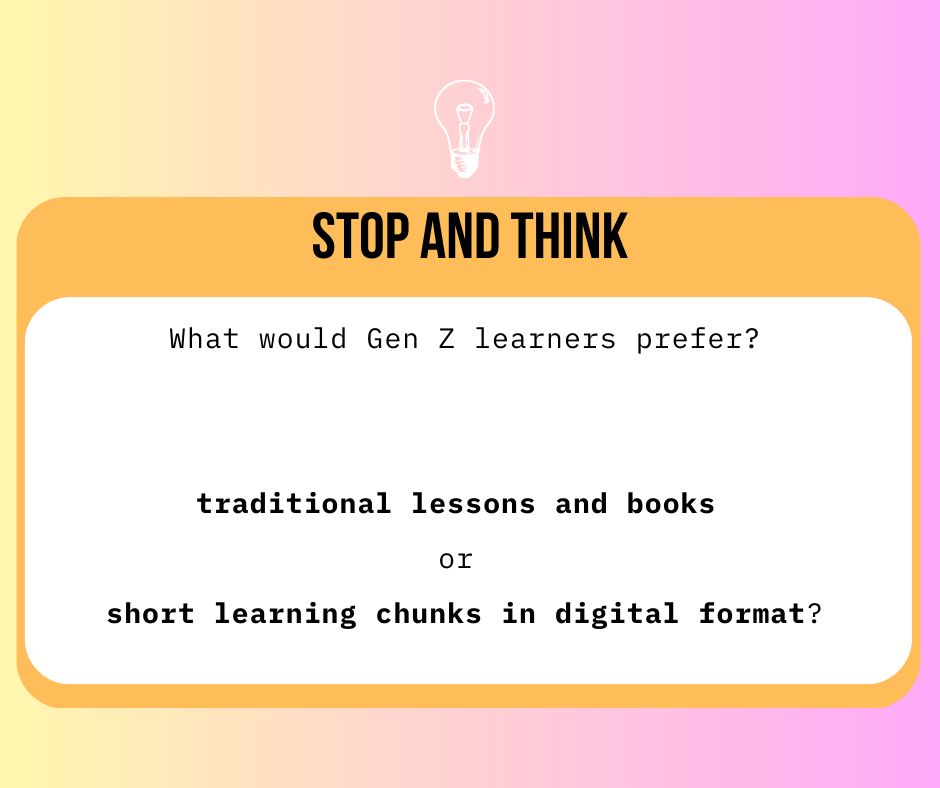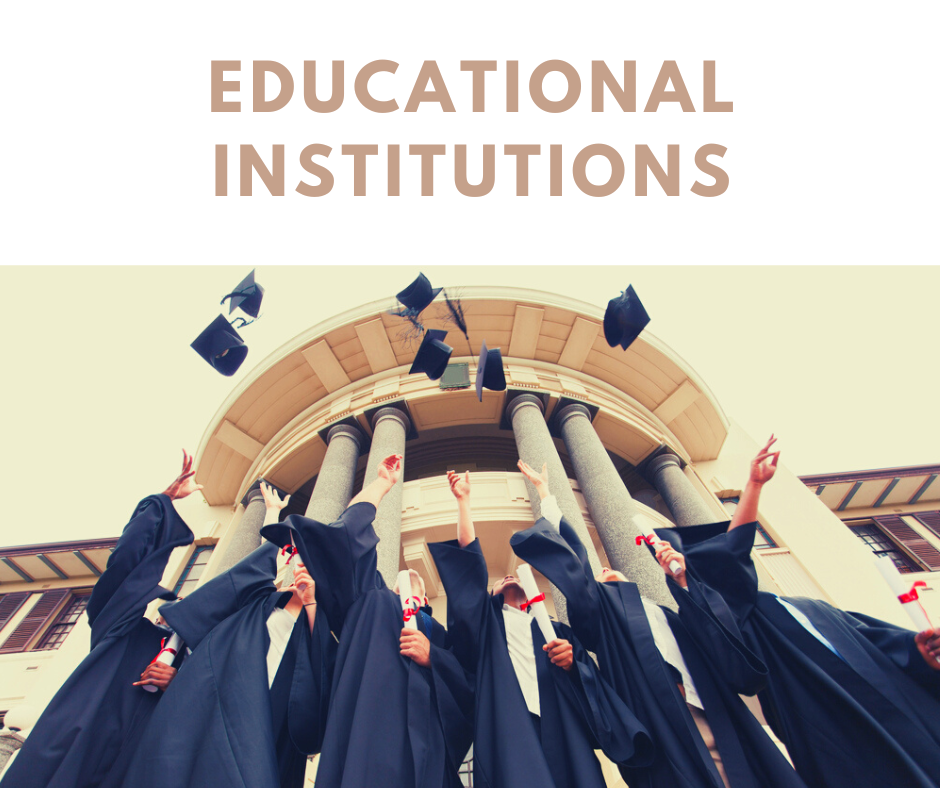Tailoring Education for the Digital Generation

A few days ago, a friend of mine left a thought-provoking comment about Gen Z on my blog post about microlearning. It was basically about how this learning approach seems to be the best option for Gen Z learners. This piqued my curiosity, and I decided to delve deeper into the topic, exploring the potential synergies between microlearning and the unique characteristics of this digitally-savvy generation. In this blog post, I'll be sharing my findings on how we process information from print and digital learning materials and why microlearning can effectively cater to the learning preferences and habits of Gen Z.
As you read, keep in mind that these are some general characteristics and it's important to note that not all individuals in a given culture or age span behave or learn in the same way. Individual differences exist in all cultures and generations.
In this article:
Understanding Gen Z
Gen Z, the generation born between 1996 and 2010, has distinctive learning preferences and habits shaped by their upbringing in a technology-rich environment.
While it is a common belief that Gen Z has a shorter attention span due to growing up in the digital age, it is important to note that research on this topic is not conclusive, and findings can be conflicting. However, some studies do suggest that attention spans may be affected by increased technology use and exposure to a vast array of digital content.
A study published in 2015 by Microsoft Canada reported that the average human attention span had decreased from 12 seconds in 2000 to 8 seconds in 2013, which is shorter than the attention span of a goldfish (9 seconds) (1). While this study did not specifically focus on Gen Z, it does provide insight into how the attention spans of people, in general, may have been affected by the digital age.
Another study published in the journal "Computers in Human Behavior" found that heavy use of digital media, especially among younger people, was associated with higher levels of attention problems (2). This suggests that increased technology use, which is characteristic of Gen Z, may contribute to attention challenges.
However, it's important to approach these findings with caution and recognise that more research is needed to draw definitive conclusions about attention spans and their relationship to technology use. Also, it's essential to remember that attention spans can be context-dependent, and Gen Z may be able to focus for extended periods in certain situations, especially when they find the subject matter engaging or relevant.

Comparing Print and Digital Materials for Effective Knowledge Acquisition
The human brain processes information from print materials and e-learning differently due to the nature of the medium and the way we interact with them. Here are a few characteristics of learning from different types of materials:
Processing Information from Print Materials
1. Visual and tactile input
When we read print materials, our brain processes the visual information from the text and images. Simultaneously, it also processes tactile input from touching and turning the pages of the book or the texture of the paper, which can help ground our reading experience.
2. Reduced distractions
Reading print materials often occurs in a focused environment with fewer distractions compared to digital media. This allows our brains to concentrate better on the content and engage in deeper cognitive processing, enhancing comprehension and retention.
3. Linear reading
Reading print materials typically follows a linear path, with readers progressing from one page to the next in a sequential manner. This enables our brains to build a narrative structure and develop a coherent understanding of the material.
Processing Information from Digital Content
1. Multimedia input
E-learning often incorporates multimedia elements such as text, images, audio, video, and interactive features. Our brains process these multiple types of sensory input simultaneously, which can enhance engagement and cater to different learning preferences but may also increase cognitive load.
2. Hyperlinked content
Digital content often includes hyperlinks, which allow learners to quickly navigate between related topics or resources. While this can provide additional context and information, it can also lead to fragmented reading patterns, making it more challenging for the brain to construct a coherent understanding of the material.
3. Increased distractions
E-learning often takes place on devices that are also used for communication, entertainment, and other activities, which can lead to increased distractions and reduced focus. As a result, our brains may engage in more shallow processing, affecting comprehension and retention.
4. Screen fatigue
Prolonged exposure to digital screens can lead to eye strain and fatigue, which can negatively impact the brain's ability to process and retain information effectively.
Despite these differences, it is essential to recognise that individual preferences, learning styles, and the specific content being taught can influence how effectively the brain processes information from print materials and e-learning. The most effective learning experiences often involve a combination of both approaches, allowing learners to benefit from the advantages of each while mitigating potential drawbacks.

Key Learning Preferences and Habits
Microlearning is generally considered a good approach for Gen Z, as it aligns with their learning preferences and habits. And here's why:
1. Digital Natives: Gen Z has grown up with technology, making them comfortable with digital learning platforms and tools. Microlearning leverages various digital formats, such as videos, quizzes, and interactive simulations, which can be accessed on multiple devices, catering to this generation's tech-savvy nature.
2. Short Attention Spans: With the abundance of information and stimuli available online, Gen Z is known for having shorter attention spans. Don't forget about the studies mentioned above showing that attention spans might be shorter, but this is also context-dependent! Microlearning's bite-sized, focused content is designed to be easily digestible and engaging, making it an ideal fit for this generation's learning style.
3. On-Demand Learning: Gen Z values instant access to information and the flexibility to learn at their own pace. Microlearning modules can be accessed on-demand, providing just-in-time learning experiences that cater to their need for flexibility and autonomy.
4. Personalised Learning: Learners used to digital content appreciate personalised learning experiences that cater to their unique needs and preferences. Microlearning's modular nature allows for easy customisation and adaptation, delivering targeted content that meets individual learning goals.
5. Collaborative Learning: Gen Z values collaboration and social interaction. Microlearning can be combined with social learning elements, such as peer-to-peer interactions, forums, or chat features, to foster collaborative learning experiences.
While microlearning is well-suited for Gen Z, it is essential to consider the specific learning objectives and content to determine if this approach fits best. Microlearning may not be ideal for all subjects or learning goals, but it can be an effective strategy for engaging Gen Z learners in many cases.
Summary
In this article, we explored the unique learning preferences of Gen Z, a generation shaped by their upbringing in a technology-rich environment. We discussed the potential of microlearning as an effective educational approach for this digitally-savvy generation, highlighting its advantages in catering to their preferences for multimedia, interactivity, on-demand learning, personalisation, and collaboration. Additionally, we examined the differences between traditional print materials and digital learning experiences, considering factors such as accessibility, cognitive processing, and the impact of distractions on comprehension and retention. By understanding these distinctions and the specific needs of Gen Z learners, educators and content creators can develop more engaging and impactful learning experiences that leverage the strengths of both print and digital materials while also harnessing the power of microlearning.
Suggested reading on the topic
(1) McSpadden, K. (2015). You Now Have a Shorter Attention Span Than a Goldfish. Time Magazine.
(2) Junco, R., & Cotten, S. R. (2012). No A 4 U: The relationship between multitasking and academic performance. Computers & Education, 59(2), 505–514. https://doi.org/10.1016/j.compedu.2011.12.023



